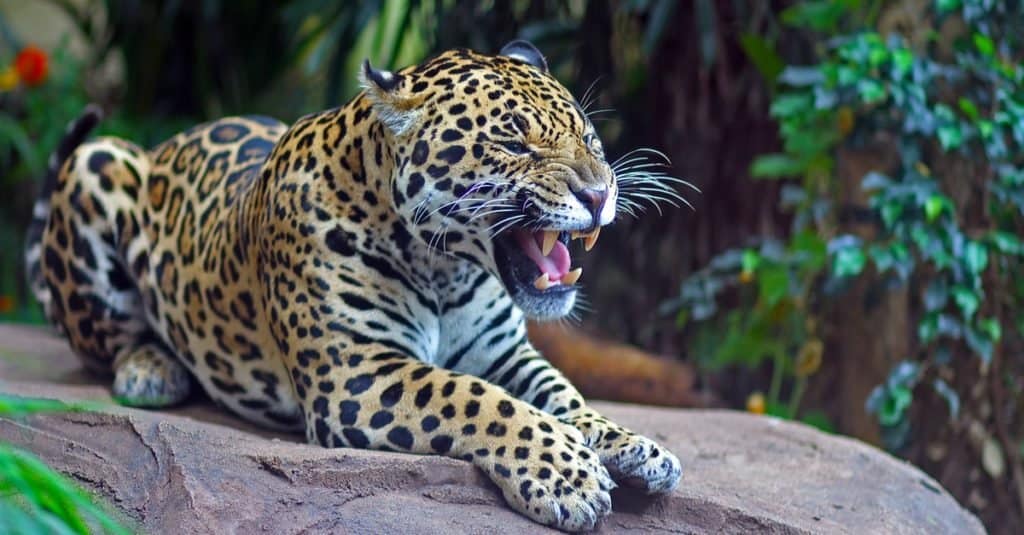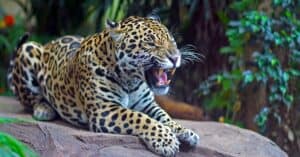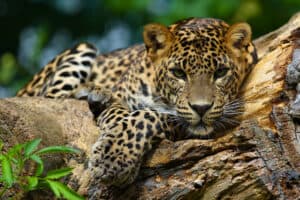
Jaguars are some of the most ferocious predators in the animal kingdom. These elegant yet intimidating members of the Panthera genus are the third-largest cats in the world and have an array of striking features, from their uniquely patterned fur to the enormous fangs they use to tear into their prey. So, what do jaguars eat, exactly?
When it comes to their diet, it’s important to remember that jaguars are extremely opportunistic apex predators and highly skilled hunters. Because of these traits, jaguars have evolved to eat more than 85 different species of animals that live alongside them within their humid rainforest habitats throughout Central and South America.
Without further ado, let’s talk about what jaguars eat and how they hunt their prey!
What Do Jaguars Eat?

A jaguar shows off its impressive fangs
©GoWildPhotography/Shutterstock.com
As you might have guessed just by looking at their massive fangs and muscular bodies, jaguars are strict carnivores that subsist entirely on the flesh and meat of other animals. They are fast, stealthy hunters that skillfully ambush and tear apart a variety of animals, from mammals and reptiles of varying sizes to fish and even birds on occasion.
Here’s a list of the many animals jaguars commonly eat in the wild:
- Deer
- Monkeys
- Turtles
- Snakes
- Caiman
- Javelinas (also known as peccaries)
- Fish
- Iguanas
- Capybaras
- Armadillos
- Tapir
- Birds
- Rabbits
- Cows
- Bird and reptile eggs
As a general rule, jaguars aren’t picky eaters. They will take down just about any animal weak or small enough for them to ambush and incapacitate with ease. Plus, as apex predators, they lack any predators to speak of. This means their rainforest habitats are essentially their own personal buffets!
So, how do jaguars manage to take down such a wide range of animals with such precision and efficiency? Let’s talk about how their bodies are perfectly suited to hunting and ripping apart their prey.
How Do Jaguars Hunt Their Prey?

A jaguar uses its teeth to tear into its unfortunate prey
©iStock.com/Steven Anderton
For jaguars, stealth is the name of the game. As nocturnal “stalk-and-ambush” predators, they will locate and follow their prey from a distance, staying just out of sight until they strike. Interestingly, the name jaguar actually originates from the Native American word yajuar, which translates to “he who kills with one leap.”
Additionally, jaguars have excellent vision, especially night vision, and huge, sharp canine teeth. These important features make it even easier for these big cats to incapacitate and devour their prey with astonishing grace and ease. While most cats within the Panthera genus kill their prey by biting and tearing at their throats, jaguars prefer to crush the skulls of their prey with their bite.
During a typical hunt, a jaguar will use its sharp night vision to locate its next meal. Then, it will slowly stalk the animal, staying just out of the animal’s line of sight, inching closer and closer until it is near enough to strike. Jaguars use the thick foliage and plant cover of their rainforest habitats to their advantage, often hiding under large leaves and branches so their prey can’t see them coming.
Finally, in the blink of an eye, the jaguar will pounce, delivering a skull-crushing bite to the back of the animal’s head. In fact, their bite force has been found to be the most powerful of all big cat species! After the jaguar crushes its prey’s skull, it then drags the animal off to a safe place such as their den, ripping it apart piece by piece with its huge teeth and powerful jaws.
The photo featured at the top of this post is © iStock.com/Steven Anderton
Thank you for reading! Have some feedback for us? Contact the AZ Animals editorial team.





